- Bibliography Answers

How to cite a website in APA, MLA, or Harvard style

There are many different ways to cite a website, depending on which citation style you need to format it in.
The easy way to cite a website in any citation style
Use our citation generator below to automatically cite a website in any style, including APA, MLA 7 and 8, and Harvard. Just select the style you need, copy the URL into the search box, and press search. We’ll do the rest.
The manual way to cite a website
To cite a website by hand just follow the instructions below. For the 3 most popular styles–APA, MLA 8, and Harvard–this is as follows:
In APA style
You need to locate these details for the website: page or article author, page or article title, website name, published date, access date, page URL (web address) .
- The author can typically be found on the page, but if there isn’t one listed you can use the website name in its place.
- The page title can be found near the top of the page, and you can also find it by hovering your mouse over the browser tab.
- The website name can usually be found in the web address or by looking for a logo or similar at the very top of the page.
- There often isn’t a publish date , but if there is it’ll be very close to the page title.
- The access date is the date you took information from the article (usually today).
- The page URL can be copied straight from the address bar of your browser and will start with either http:// or https://.
Then use this template, replacing the colored placeholders with the information you found on the page:
Author last name , author first name initial . ( published year , published month and day ). Page title . Retrieved accessed month and day , accessed year , from article URL .
The final formatted citation should look like this:
Ingle, S. (2018, February 11). Winter Olympics was hit by cyber-attack, officials confirm. Retrieved July 24, 2018, from https://www.theguardian.com/sport/2018/feb/11/winter-olympics-was-hit-by-cyber-attack-officials-confirm.
For a more comprehensive guide, including what to do when you can’t find certain details, have a look at our more in-depth guide to citing a website in APA format .
In MLA 8 style
Here are the specific details you need to find on the page: page or article author, page or article title, website name, published date, access date, page URL (web address) .
Then use this template:
Author last name , author first name . “ Page title .” website name , published date day, month, year , page URL . Accessed accessed date day, month, year .
Ingle, Sean. “Winter Olympics Was Hit by Cyber-Attack, Officials Confirm.” The Guardian , 11 Feb. 2018, https://www.theguardian.com/sport/2018/feb/11/winter-olympics-was-hit-by-cyber-attack-officials-confirm. Accessed 13 July 2018.
For a more comprehensive guide, including what to do when you can’t find certain details, have a look at our more in-depth guide to citing a website in MLA 8 format .
In Harvard style
First, find these details for the website: page or article author, page or article title, website name, published date, access date, page URL (web address) .
Author last name , author firstname initial ( published date year ). Page title . [online] website name . Available at: page URL [Accessed accessed date day, month, year ].
Ingle, S. (2018). Winter Olympics was hit by cyber-attack, officials confirm . [online] The Guardian. Available at: https://www.theguardian.com/sport/2018/feb/11/winter-olympics-was-hit-by-cyber-attack-officials-confirm [Accessed 13 Jul. 2018].
Daniel is a qualified librarian, former teacher, and citation expert. He has been contributing to MyBib since 2018.
- PRO Courses Guides New Tech Help Pro Expert Videos About wikiHow Pro Upgrade Sign In
- EDIT Edit this Article
- EXPLORE Tech Help Pro About Us Random Article Quizzes Request a New Article Community Dashboard This Or That Game Happiness Hub Popular Categories Arts and Entertainment Artwork Books Movies Computers and Electronics Computers Phone Skills Technology Hacks Health Men's Health Mental Health Women's Health Relationships Dating Love Relationship Issues Hobbies and Crafts Crafts Drawing Games Education & Communication Communication Skills Personal Development Studying Personal Care and Style Fashion Hair Care Personal Hygiene Youth Personal Care School Stuff Dating All Categories Arts and Entertainment Finance and Business Home and Garden Relationship Quizzes Cars & Other Vehicles Food and Entertaining Personal Care and Style Sports and Fitness Computers and Electronics Health Pets and Animals Travel Education & Communication Hobbies and Crafts Philosophy and Religion Work World Family Life Holidays and Traditions Relationships Youth
- Browse Articles
- Learn Something New
- Quizzes Hot
- Happiness Hub
- This Or That Game
- Train Your Brain
- Explore More
- Support wikiHow
- About wikiHow
- Log in / Sign up
- Education and Communications
- College University and Postgraduate
- Academic Writing
How to Cite a Website
Last Updated: February 9, 2023 Fact Checked
This article was co-authored by Michelle Golden, PhD and by wikiHow staff writer, Jennifer Mueller, JD . Michelle Golden is an English teacher in Athens, Georgia. She received her MA in Language Arts Teacher Education in 2008 and received her PhD in English from Georgia State University in 2015. There are 7 references cited in this article, which can be found at the bottom of the page. This article has been fact-checked, ensuring the accuracy of any cited facts and confirming the authority of its sources. This article has been viewed 3,566,084 times.
If you're writing a research paper, you'll likely do quite a bit of research online. If you have websites that you want to use as sources for your paper, an entry for the website must appear in the reference list (also called the bibliography or Works Cited) at the end of your paper. You'll also include a citation in-text at the end of any sentence in which you've paraphrased or quoted information that appeared on that website. While the information you need to provide is generally the same across all methods, the way you format that information may vary depending on whether you're using the Modern Language Association (MLA), American Psychological Association (APA), or Chicago style of citation.
Sample Citation Templates

- Example: Claymore, Crystal.
- If no individual author is listed, but the website is produced by a government agency, organization, or business, use that name as the author. For example, if you're using a CDC web page as a source, you would list the author as "Centers for Disease Control and Prevention."
Tip: For your entire Works Cited entry, if an element doesn't exist or isn't provided, simply skip that part of the citation and move on to the next part.

- Example: Claymore, Crystal. "Best-Kept Secrets for Amazing Cupcake Frosting."

- Example: Claymore, Crystal. "Best-Kept Secrets for Amazing Cupcake Frosting." Crystal's Cupcakes , 24 Sept. 2018,

- Example: Claymore, Crystal. "Best-Kept Secrets for Amazing Cupcake Frosting." Crystal's Cupcakes , 24 Sept. 2018, www.crystalscupcakes.com/amazing-frosting.

- Example: Claymore, Crystal. "Best-Kept Secrets for Amazing Cupcake Frosting." Crystal's Cupcakes , www.crystalscupcakes.com/amazing-frosting. Accessed 14 Feb. 2019.
MLA Works Cited Format:
Author Last Name, First Name. "Title of Web Page in Title Case." Name of Website , Day Month Year of publication, URL. Accessed Day Month Year.

- For example, you might write: "The best cupcake frosting techniques are often the least intuitive (Claymore)."
- If you include the author's name in your text, there's no need for a parenthetical citation. For example, you might write: "Award-winning baker Crystal Claymore wasn't afraid to give away all her secrets, sharing her favorite frosting techniques on her website."

- Example: Canadian Cancer Society.

- Example: Canadian Cancer Society. (2017).
- If you're citing several pages from the same website that were published in the same year, add a lower-case letter to the end of the year so you can differentiate them in your in-text citations. For example, you might have "2017a" and "2017b."

- Example: Canadian Cancer Society. (2017). Cancer research.
- If the content you're citing is a stand-alone document, the title should be italicized. This will usually be the case if you're citing a PDF document that appears on a website. If you're not sure, use your best judgment in deciding whether to italicize it or not.

- Example: Canadian Cancer Society. (2017). Cancer research. Retrieved from http://www.cancer.ca/en/cancer-information/cancer-101/cancer-research/?region=on
APA Reference List Format:
Author Last Name, A. A. (Year). Title of web page in sentence case. Retrieved from URL

- For example, you might write: "Clinical trials are used to test new cancer treatments (Canadian Cancer Society, 2017)."
- If you include the author's name in your text, place the year in parentheses immediately after the author's name. For example, you might write: "The Canadian Cancer Society (2017) noted that Canada is a global leader in clinical trials of cancer treatments."

- Example: UN Women.

- Example: UN Women. "Commission on the Status of Women."

- Example: UN Women. "Commission on the Status of Women." UN Women .

- Example: UN Women. "Commission on the Status of Women." UN Women . Accessed February 14, 2019.

- Example: UN Women. "Commission on the Status of Women." UN Women . Accessed February 14, 2019. http://www.unwomen.org/en/csw.
Chicago Bibliography Format:
Author Last Name, First Name. "Title of Web Page in Title Case." Name of Website or Publishing Organization . Accessed Month Day, Year. URL.

- Example: UN Women, "Commission on the Status of Women," UN Women , accessed February 14, 2019, http://www.unwomen.org/en/csw.
Community Q&A

You Might Also Like

- ↑ https://owl.purdue.edu/owl/research_and_citation/mla_style/mla_formatting_and_style_guide/mla_works_cited_electronic_sources.html
- ↑ https://libguides.up.edu/mla/common/websites
- ↑ https://owl.purdue.edu/owl/research_and_citation/apa_style/apa_formatting_and_style_guide/reference_list_electronic_sources.html
- ↑ https://libraryguides.vu.edu.au/apa-referencing/7Webpages
- ↑ https://apastyle.apa.org/style-grammar-guidelines/references/examples/webpage-website-references
- ↑ https://owl.purdue.edu/owl/research_and_citation/chicago_manual_17th_edition/cmos_formatting_and_style_guide/web_sources.html
- ↑ http://libanswers.snhu.edu/faq/48009
About This Article

To cite a website in text using MLA formatting, include the author's last name in parentheses at the end of the sentence you're using the source in. If there is no author, include the title of the web page instead. If you're using APA formatting, include the author's last name followed by a comma and the year of publication in parentheses at the end of the sentence. If you don't know the author's name, use the name of the web page instead. For more tips from our English co-author, like how to cite a website in Chicago style, scroll down! Did this summary help you? Yes No
- Send fan mail to authors
Reader Success Stories
Nov 28, 2016
Did this article help you?
Oct 2, 2017
Oct 5, 2018
Abraham Mathews
Nov 28, 2018
Apr 19, 2018

Featured Articles

Trending Articles

Watch Articles

- Terms of Use
- Privacy Policy
- Do Not Sell or Share My Info
- Not Selling Info
Get all the best how-tos!
Sign up for wikiHow's weekly email newsletter
Home / Guides / Citation Guides / How to Cite Sources
How to Cite Sources
Here is a complete list for how to cite sources. Most of these guides present citation guidance and examples in MLA, APA, and Chicago.
If you’re looking for general information on MLA or APA citations , the EasyBib Writing Center was designed for you! It has articles on what’s needed in an MLA in-text citation , how to format an APA paper, what an MLA annotated bibliography is, making an MLA works cited page, and much more!
MLA Format Citation Examples
The Modern Language Association created the MLA Style, currently in its 9th edition, to provide researchers with guidelines for writing and documenting scholarly borrowings. Most often used in the humanities, MLA style (or MLA format ) has been adopted and used by numerous other disciplines, in multiple parts of the world.
MLA provides standard rules to follow so that most research papers are formatted in a similar manner. This makes it easier for readers to comprehend the information. The MLA in-text citation guidelines, MLA works cited standards, and MLA annotated bibliography instructions provide scholars with the information they need to properly cite sources in their research papers, articles, and assignments.
- Book Chapter
- Conference Paper
- Documentary
- Encyclopedia
- Google Images
- Kindle Book
- Memorial Inscription
- Museum Exhibit
- Painting or Artwork
- PowerPoint Presentation
- Sheet Music
- Thesis or Dissertation
- YouTube Video
APA Format Citation Examples
The American Psychological Association created the APA citation style in 1929 as a way to help psychologists, anthropologists, and even business managers establish one common way to cite sources and present content.
APA is used when citing sources for academic articles such as journals, and is intended to help readers better comprehend content, and to avoid language bias wherever possible. The APA style (or APA format ) is now in its 7th edition, and provides citation style guides for virtually any type of resource.
Chicago Style Citation Examples
The Chicago/Turabian style of citing sources is generally used when citing sources for humanities papers, and is best known for its requirement that writers place bibliographic citations at the bottom of a page (in Chicago-format footnotes ) or at the end of a paper (endnotes).
The Turabian and Chicago citation styles are almost identical, but the Turabian style is geared towards student published papers such as theses and dissertations, while the Chicago style provides guidelines for all types of publications. This is why you’ll commonly see Chicago style and Turabian style presented together. The Chicago Manual of Style is currently in its 17th edition, and Turabian’s A Manual for Writers of Research Papers, Theses, and Dissertations is in its 8th edition.
Citing Specific Sources or Events
- Declaration of Independence
- Gettysburg Address
- Martin Luther King Jr. Speech
- President Obama’s Farewell Address
- President Trump’s Inauguration Speech
- White House Press Briefing
Additional FAQs
- Citing Archived Contributors
- Citing a Blog
- Citing a Book Chapter
- Citing a Source in a Foreign Language
- Citing an Image
- Citing a Song
- Citing Special Contributors
- Citing a Translated Article
- Citing a Tweet
6 Interesting Citation Facts
The world of citations may seem cut and dry, but there’s more to them than just specific capitalization rules, MLA in-text citations , and other formatting specifications. Citations have been helping researches document their sources for hundreds of years, and are a great way to learn more about a particular subject area.
Ever wonder what sets all the different styles apart, or how they came to be in the first place? Read on for some interesting facts about citations!
1. There are Over 7,000 Different Citation Styles
You may be familiar with MLA and APA citation styles, but there are actually thousands of citation styles used for all different academic disciplines all across the world. Deciding which one to use can be difficult, so be sure to ask you instructor which one you should be using for your next paper.
2. Some Citation Styles are Named After People
While a majority of citation styles are named for the specific organizations that publish them (i.e. APA is published by the American Psychological Association, and MLA format is named for the Modern Language Association), some are actually named after individuals. The most well-known example of this is perhaps Turabian style, named for Kate L. Turabian, an American educator and writer. She developed this style as a condensed version of the Chicago Manual of Style in order to present a more concise set of rules to students.
3. There are Some Really Specific and Uniquely Named Citation Styles
How specific can citation styles get? The answer is very. For example, the “Flavour and Fragrance Journal” style is based on a bimonthly, peer-reviewed scientific journal published since 1985 by John Wiley & Sons. It publishes original research articles, reviews and special reports on all aspects of flavor and fragrance. Another example is “Nordic Pulp and Paper Research,” a style used by an international scientific magazine covering science and technology for the areas of wood or bio-mass constituents.
4. More citations were created on EasyBib.com in the first quarter of 2018 than there are people in California.
The US Census Bureau estimates that approximately 39.5 million people live in the state of California. Meanwhile, about 43 million citations were made on EasyBib from January to March of 2018. That’s a lot of citations.
5. “Citations” is a Word With a Long History
The word “citations” can be traced back literally thousands of years to the Latin word “citare” meaning “to summon, urge, call; put in sudden motion, call forward; rouse, excite.” The word then took on its more modern meaning and relevance to writing papers in the 1600s, where it became known as the “act of citing or quoting a passage from a book, etc.”
6. Citation Styles are Always Changing
The concept of citations always stays the same. It is a means of preventing plagiarism and demonstrating where you relied on outside sources. The specific style rules, however, can and do change regularly. For example, in 2018 alone, 46 new citation styles were introduced , and 106 updates were made to exiting styles. At EasyBib, we are always on the lookout for ways to improve our styles and opportunities to add new ones to our list.
Why Citations Matter
Here are the ways accurate citations can help your students achieve academic success, and how you can answer the dreaded question, “why should I cite my sources?”
They Give Credit to the Right People
Citing their sources makes sure that the reader can differentiate the student’s original thoughts from those of other researchers. Not only does this make sure that the sources they use receive proper credit for their work, it ensures that the student receives deserved recognition for their unique contributions to the topic. Whether the student is citing in MLA format , APA format , or any other style, citations serve as a natural way to place a student’s work in the broader context of the subject area, and serve as an easy way to gauge their commitment to the project.
They Provide Hard Evidence of Ideas
Having many citations from a wide variety of sources related to their idea means that the student is working on a well-researched and respected subject. Citing sources that back up their claim creates room for fact-checking and further research . And, if they can cite a few sources that have the converse opinion or idea, and then demonstrate to the reader why they believe that that viewpoint is wrong by again citing credible sources, the student is well on their way to winning over the reader and cementing their point of view.
They Promote Originality and Prevent Plagiarism
The point of research projects is not to regurgitate information that can already be found elsewhere. We have Google for that! What the student’s project should aim to do is promote an original idea or a spin on an existing idea, and use reliable sources to promote that idea. Copying or directly referencing a source without proper citation can lead to not only a poor grade, but accusations of academic dishonesty. By citing their sources regularly and accurately, students can easily avoid the trap of plagiarism , and promote further research on their topic.
They Create Better Researchers
By researching sources to back up and promote their ideas, students are becoming better researchers without even knowing it! Each time a new source is read or researched, the student is becoming more engaged with the project and is developing a deeper understanding of the subject area. Proper citations demonstrate a breadth of the student’s reading and dedication to the project itself. By creating citations, students are compelled to make connections between their sources and discern research patterns. Each time they complete this process, they are helping themselves become better researchers and writers overall.
When is the Right Time to Start Making Citations?
Make in-text/parenthetical citations as you need them.
As you are writing your paper, be sure to include references within the text that correspond with references in a works cited or bibliography. These are usually called in-text citations or parenthetical citations in MLA and APA formats. The most effective time to complete these is directly after you have made your reference to another source. For instance, after writing the line from Charles Dickens’ A Tale of Two Cities : “It was the best of times, it was the worst of times…,” you would include a citation like this (depending on your chosen citation style):
(Dickens 11).
This signals to the reader that you have referenced an outside source. What’s great about this system is that the in-text citations serve as a natural list for all of the citations you have made in your paper, which will make completing the works cited page a whole lot easier. After you are done writing, all that will be left for you to do is scan your paper for these references, and then build a works cited page that includes a citation for each one.
Need help creating an MLA works cited page ? Try the MLA format generator on EasyBib.com! We also have a guide on how to format an APA reference page .
2. Understand the General Formatting Rules of Your Citation Style Before You Start Writing
While reading up on paper formatting may not sound exciting, being aware of how your paper should look early on in the paper writing process is super important. Citation styles can dictate more than just the appearance of the citations themselves, but rather can impact the layout of your paper as a whole, with specific guidelines concerning margin width, title treatment, and even font size and spacing. Knowing how to organize your paper before you start writing will ensure that you do not receive a low grade for something as trivial as forgetting a hanging indent.
Don’t know where to start? Here’s a formatting guide on APA format .
3. Double-check All of Your Outside Sources for Relevance and Trustworthiness First
Collecting outside sources that support your research and specific topic is a critical step in writing an effective paper. But before you run to the library and grab the first 20 books you can lay your hands on, keep in mind that selecting a source to include in your paper should not be taken lightly. Before you proceed with using it to backup your ideas, run a quick Internet search for it and see if other scholars in your field have written about it as well. Check to see if there are book reviews about it or peer accolades. If you spot something that seems off to you, you may want to consider leaving it out of your work. Doing this before your start making citations can save you a ton of time in the long run.
Finished with your paper? It may be time to run it through a grammar and plagiarism checker , like the one offered by EasyBib Plus. If you’re just looking to brush up on the basics, our grammar guides are ready anytime you are.
How useful was this post?
Click on a star to rate it!
We are sorry that this post was not useful for you!
Let us improve this post!
Tell us how we can improve this post?
Citation Basics
Harvard Referencing
Plagiarism Basics
Plagiarism Checker
Upload a paper to check for plagiarism against billions of sources and get advanced writing suggestions for clarity and style.
Get Started
Purdue Online Writing Lab Purdue OWL® College of Liberal Arts
In-Text Citations: The Basics

Welcome to the Purdue OWL
This page is brought to you by the OWL at Purdue University. When printing this page, you must include the entire legal notice.
Copyright ©1995-2018 by The Writing Lab & The OWL at Purdue and Purdue University. All rights reserved. This material may not be published, reproduced, broadcast, rewritten, or redistributed without permission. Use of this site constitutes acceptance of our terms and conditions of fair use.
Note: This page reflects the latest version of the APA Publication Manual (i.e., APA 7), which released in October 2019. The equivalent resource for the older APA 6 style can be found here .
Reference citations in text are covered on pages 261-268 of the Publication Manual. What follows are some general guidelines for referring to the works of others in your essay.
Note: On pages 117-118, the Publication Manual suggests that authors of research papers should use the past tense or present perfect tense for signal phrases that occur in the literature review and procedure descriptions (for example, Jones (1998) found or Jones (1998) has found ...). Contexts other than traditionally-structured research writing may permit the simple present tense (for example, Jones (1998) finds ).
APA Citation Basics
When using APA format, follow the author-date method of in-text citation. This means that the author's last name and the year of publication for the source should appear in the text, like, for example, (Jones, 1998). One complete reference for each source should appear in the reference list at the end of the paper.
If you are referring to an idea from another work but NOT directly quoting the material, or making reference to an entire book, article or other work, you only have to make reference to the author and year of publication and not the page number in your in-text reference.
On the other hand, if you are directly quoting or borrowing from another work, you should include the page number at the end of the parenthetical citation. Use the abbreviation “p.” (for one page) or “pp.” (for multiple pages) before listing the page number(s). Use an en dash for page ranges. For example, you might write (Jones, 1998, p. 199) or (Jones, 1998, pp. 199–201). This information is reiterated below.
Regardless of how they are referenced, all sources that are cited in the text must appear in the reference list at the end of the paper.
In-text citation capitalization, quotes, and italics/underlining
- Always capitalize proper nouns, including author names and initials: D. Jones.
- If you refer to the title of a source within your paper, capitalize all words that are four letters long or greater within the title of a source: Permanence and Change . Exceptions apply to short words that are verbs, nouns, pronouns, adjectives, and adverbs: Writing New Media , There Is Nothing Left to Lose .
( Note: in your References list, only the first word of a title will be capitalized: Writing new media .)
- When capitalizing titles, capitalize both words in a hyphenated compound word: Natural-Born Cyborgs .
- Capitalize the first word after a dash or colon: "Defining Film Rhetoric: The Case of Hitchcock's Vertigo ."
- If the title of the work is italicized in your reference list, italicize it and use title case capitalization in the text: The Closing of the American Mind ; The Wizard of Oz ; Friends .
- If the title of the work is not italicized in your reference list, use double quotation marks and title case capitalization (even though the reference list uses sentence case): "Multimedia Narration: Constructing Possible Worlds;" "The One Where Chandler Can't Cry."
Short quotations
If you are directly quoting from a work, you will need to include the author, year of publication, and page number for the reference (preceded by "p." for a single page and “pp.” for a span of multiple pages, with the page numbers separated by an en dash).
You can introduce the quotation with a signal phrase that includes the author's last name followed by the date of publication in parentheses.
If you do not include the author’s name in the text of the sentence, place the author's last name, the year of publication, and the page number in parentheses after the quotation.
Long quotations
Place direct quotations that are 40 words or longer in a free-standing block of typewritten lines and omit quotation marks. Start the quotation on a new line, indented 1/2 inch from the left margin, i.e., in the same place you would begin a new paragraph. Type the entire quotation on the new margin, and indent the first line of any subsequent paragraph within the quotation 1/2 inch from the new margin. Maintain double-spacing throughout, but do not add an extra blank line before or after it. The parenthetical citation should come after the closing punctuation mark.
Because block quotation formatting is difficult for us to replicate in the OWL's content management system, we have simply provided a screenshot of a generic example below.

Formatting example for block quotations in APA 7 style.
Quotations from sources without pages
Direct quotations from sources that do not contain pages should not reference a page number. Instead, you may reference another logical identifying element: a paragraph, a chapter number, a section number, a table number, or something else. Older works (like religious texts) can also incorporate special location identifiers like verse numbers. In short: pick a substitute for page numbers that makes sense for your source.
Summary or paraphrase
If you are paraphrasing an idea from another work, you only have to make reference to the author and year of publication in your in-text reference and may omit the page numbers. APA guidelines, however, do encourage including a page range for a summary or paraphrase when it will help the reader find the information in a longer work.
- Jump to menu
- Student Home
- Accept your offer
- How to enrol
- Student ID card
- Set up your IT
- Orientation Week
- Fees & payment
- Academic calendar
- Special consideration
- Transcripts
- The Nucleus: Student Hub
- Referencing
- Essay writing
- Learning abroad & exchange
- Professional development & UNSW Advantage
- Employability
- Financial assistance
- International students
- Equitable learning
- Postgraduate research
- Health Service
- Events & activities
- Emergencies
- Volunteering
- Clubs and societies
- Accommodation
- Health services
- Sport and gym
- Arc student organisation
- Security on campus
- Maps of campus
- Careers portal
- Change password
How to Cite a Website and Online/Electronic Resources
The pages outlines examples of how to cite websites and media sources using the Harvard Referencing method .
What are electronic sources?
An electronic source is any information source in digital format. The library subscribes to many electronic information resources in order to provide access for students. Electronic sources can include: full-text journals, newspapers, company information, e-books, dictionaries, encyclopaedias, economic data, digital images, industry profiles, market research, etc.
Should I include extra information when I cite electronic sources?
Referencing electronic or online sources can be confusing—it's difficult to know which information to include or where to find it. As a rule, provide as much information as possible concerning authorship, location and availability.
Electronic or online sources require much of the same information as print sources (author, year of publication, title, publisher). However, in some cases extra information may be required:
- the page, paragraph or section number—what you cite will depend on the information available as many electronic or online sources don’t have pages.
- identify the format of the source accessed, for example, E-book, podcast etc.
- provide an accurate access date for online sources, that is, identify when a source was viewed or downloaded.
- provide the location of an online source, for example, a database or web address.
In-text citations
Cite the name of the author/ organisation responsible for the site and the date created or last revised (use the most recent date):
(Department of Social Services 2020)
According to the Department of Social Services (2020) ...
List of References
Include information in the following order:
- author (the person or organisation responsible for the site
- year (date created or revised)
- site name (in italics)
- name of sponsor of site (if available)
- accessed day month year (the date you viewed the site)
- URL or Internet address (between pointed brackets). If possible, ensure that the URL is included without a line-break.
Department of Social Services 2020, Department of social services website , Australian government, accessed 20 February 2020, <https: //www .dss.gov.au/>.
Specific pages or documents within a website
Information should include author/authoring body name(s) and the date created or last revised:
(Li 2004) or:
(World Health Organisation 2013)
- author (the person or organisation responsible for the site)
- year (date created or last updated)
- page title (in italics)
- name of sponsor of site (if available)
- accessed day month year (the day you viewed the site)
- URL or Internet address (pointed brackets).
One author:
Li, L 2014, Chinese scroll painting H533 , Australian Museum, accessed 20 February 2016, <https: // australianmuseum.net.au/chinese-scroll-painting-h533>.
Organisation as author:
World Health Organisation 2013, Financial crisis and global health , The United Nations, accessed 1 August 2013, <http: //www .who.int/topics/financial_crisis/en/>.
Webpages with no author or date
If the author's name is unknown, cite the website/page title and date:
( Land for sale on moon 2007)
Land for sale on moon 2007, accessed 19 June 2007, <http: // www . moonlandrealestate.com>.
If there is not date on the page, use the abbreviation n.d. (no date):
(ArtsNSW n.d.)
List if References
ArtsNSW n.d., New South Wales Premier’s Literary Awards , NSW Department of the Arts, Sport and Recreation, accessed 19 June 2007, <http: // www . arts.nsw.gov.au/awards/ LiteraryAwards/litawards.htm>.
Kim, M n.d., Chinese New Year pictures and propaganda posters , Museum of Applied Arts and Sciences, accessed 12 April 2016, <https: // collection.maas.museum/set/6274>.
Media articles (print)
If there is no author, list the name of the newspaper, the date, year and page number:
( The Independent 2013, p. 36)
If there is an author, cite as you would for a journal article:
(Donaghy 1994, p. 3)
Articles can also be mentioned in the running text:
University rankings were examined in a Sydney Morning Herald report by Williamson (1998, p. 21), where it was evident that ...
- year of publication
- article title (between single quotation marks)
- publication title (in italics with maximum capitalisation)
- date of article (day, month)
- page number
Williamson, S 1998, ‘UNSW gains top ranking from quality team’, Sydney Morning Herald , 30 February, p.21.
Donaghy, B 1994, ‘National meeting set to review tertiary admissions’, Campus News , 3-9 March, p. 3.
An unattributed newspaper article:
If there is no named author, list the article title first:
- Article title, between single quotation marks,
- Publication title (in italics with maximum capitalisation)
- Date published (date, month, year)
- Page number (if available)
‘Baby tapir wins hearts at zoo’, The Independent , 9 August 2013, p. 36
Online media articles
A news article from an electronic database:
If the article has a named author:
(Pianin 2001)
- author (if available)
- newspaper title (in italics)
- date of article (day, month, page number—if given—and any additional information available)
- accessed day month year (the date you accessed the items)
- from name of database
- item number (if given).
Pianin, E 2001, 'As coal's fortunes climb, mountains tremble in W.Va; energy policy is transforming lives', The Washington Post, 25 February, p. A03, accessed March 2001 from Electric Library Australasia.
A news article without a named author:
No named author:
( New York Daily Times 1830)
The article can also be discussed in the body of the paragraph:
An account of the popularity of the baby tapir in The Independent (2013) stated that ...
If there is no named author, list the article title first.
'Amending the Constitution', New York Daily Times , 16 October 1851, p. 2, accessed 15 July 2007 from ProQuest Historical Newspapers database.
'Baby tapir wins hearts at zoo', The Independent , 9 August 2013, Accessed 25 January 2014, <http: // www . independent.ie/world-news/and-finally/baby-tapir-wins-hearts-at-zoo-30495570.html>.
An online news article:
Cite the author name and year:
(Coorey 2007)
Coorey, P 2007, ‘Costello hints at green safety net’, Sydney Morning Herald , 10 May, accessed 14 May 2012, <http: // www . smh.com.au/news/business/costello-hints-at-green-safety-net/2007/05/09/1178390393875.html>.
While a URL for the article should be included, if it is very long (more than two lines) or unfixed (from a search engine), only include the publication URL:
Holmes, L 2017, 'The woman making a living out of pretending to be Kylie Minogue', The Daily Telegraph , 23 April, accessed 22 May 2017, <http: // www . dailytelegraph.com.au>.
Media releases
Cite the author (the person responsible for the release) and date:
Prime Minister Howard (2007) announced plans for further welfare reform...
- author name or authoring organisation name
- title of release (in italics)
- accessed day month year
- URL (between pointed brackets)
Office of the Prime Minister 2007, Welfare Payments Reform , media release, accessed 25 July 2007, <http: // www . pm.gov.au/media/Release/2007/Media_Release24432.cfm>.
How to cite broadcast materials and communications
Harvard referencing
- How to cite different sources
- How to cite references
- How to cite online/electronic sources
- Broadcast and other sources
- Citing images and tables
- FAQs and troubleshooting
- About this guide
- ^ More support
Have a language expert improve your writing
Run a free plagiarism check in 10 minutes, automatically generate references for free.
- Knowledge Base
- Referencing
A Quick Guide to Referencing | Cite Your Sources Correctly
Referencing means acknowledging the sources you have used in your writing. Including references helps you support your claims and ensures that you avoid plagiarism .
There are many referencing styles, but they usually consist of two things:
- A citation wherever you refer to a source in your text.
- A reference list or bibliography at the end listing full details of all your sources.
The most common method of referencing in UK universities is Harvard style , which uses author-date citations in the text. Our free Harvard Reference Generator automatically creates accurate references in this style.
| (Smith, 2013) | |
| Smith, J. (2013) . 2nd ed. London: Penguin. |
Instantly correct all language mistakes in your text
Be assured that you'll submit flawless writing. Upload your document to correct all your mistakes.

Table of contents
Referencing styles, citing your sources with in-text citations, creating your reference list or bibliography, harvard referencing examples, frequently asked questions about referencing.
Each referencing style has different rules for presenting source information. For in-text citations, some use footnotes or endnotes , while others include the author’s surname and date of publication in brackets in the text.
The reference list or bibliography is presented differently in each style, with different rules for things like capitalisation, italics, and quotation marks in references.
Your university will usually tell you which referencing style to use; they may even have their own unique style. Always follow your university’s guidelines, and ask your tutor if you are unsure. The most common styles are summarised below.
Harvard referencing, the most commonly used style at UK universities, uses author–date in-text citations corresponding to an alphabetical bibliography or reference list at the end.
| In-text citation | Sources should always be cited properly (Pears and Shields, 2019). |
|---|---|
| Reference list | Pears, R. and Shields, G. (2019) . 11th edn. London: MacMillan. |
Harvard Referencing Guide
Vancouver referencing, used in biomedicine and other sciences, uses reference numbers in the text corresponding to a numbered reference list at the end.
| In-text citation | Sources should always be cited properly (1). |
|---|---|
| Reference list | 1. Pears R, Shields G. Cite them right: The essential referencing guide. 11th ed. London: MacMillan; 2019. |
Vancouver Referencing Guide
APA referencing, used in the social and behavioural sciences, uses author–date in-text citations corresponding to an alphabetical reference list at the end.
| In-text citation | Sources should always be cited properly (Pears & Shields, 2019). |
|---|---|
| Reference list | Pears, R., & Shields, G. (2019). (11th ed.). London, England: MacMillan. |
APA Referencing Guide APA Reference Generator
MHRA referencing, used in the humanities, uses footnotes in the text with source information, in addition to an alphabetised bibliography at the end.
| In-text citation | Sources should always be cited properly. |
|---|---|
| Footnote | 1. Richard Pears and Graham Shields, , 11th edn (London: MacMillan, 2019). |
| Bibliography | Pears, Richard and Graham Shields, , 11th edn (London: MacMillan, 2019). |
MHRA Referencing Guide
OSCOLA referencing, used in law, uses footnotes in the text with source information, and an alphabetical bibliography at the end in longer texts.
| In-text citation | Sources should always be cited properly. |
|---|---|
| Footnote | 1. Richard Pears and Graham Shields, (11th edn, MacMillan 2019). |
| Bibliography | Pears R and Shields G, (11th edn, MacMillan 2019). |
OSCOLA Referencing Guide
Prevent plagiarism, run a free check.
In-text citations should be used whenever you quote, paraphrase, or refer to information from a source (e.g. a book, article, image, website, or video).
Quoting and paraphrasing
Quoting is when you directly copy some text from a source and enclose it in quotation marks to indicate that it is not your own writing.
Paraphrasing is when you rephrase the original source into your own words. In this case, you don’t use quotation marks, but you still need to include a citation.
In most referencing styles, page numbers are included when you’re quoting or paraphrasing a particular passage. If you are referring to the text as a whole, no page number is needed.
In-text citations
In-text citations are quick references to your sources. In Harvard referencing, you use the author’s surname and the date of publication in brackets.
Up to three authors are included in a Harvard in-text citation. If the source has more than three authors, include the first author followed by ‘ et al. ‘
| Number of authors | Harvard in-text citation example |
|---|---|
| 1 author | (Jones, 2017) |
| 2 authors | (Jones and Singh, 2017) |
| 3 authors | (Jones, Singh and Smith, 2017) |
| 4+ authors | (Jones et al., 2017) |
The point of these citations is to direct your reader to the alphabetised reference list, where you give full information about each source. For example, to find the source cited above, the reader would look under ‘J’ in your reference list to find the title and publication details of the source.
Placement of in-text citations
In-text citations should be placed directly after the quotation or information they refer to, usually before a comma or full stop. If a sentence is supported by multiple sources, you can combine them in one set of brackets, separated by a semicolon.
If you mention the author’s name in the text already, you don’t include it in the citation, and you can place the citation immediately after the name.
- Another researcher warns that the results of this method are ‘inconsistent’ (Singh, 2018, p. 13) .
- Previous research has frequently illustrated the pitfalls of this method (Singh, 2018; Jones, 2016) .
- Singh (2018, p. 13) warns that the results of this method are ‘inconsistent’.
The terms ‘bibliography’ and ‘reference list’ are sometimes used interchangeably. Both refer to a list that contains full information on all the sources cited in your text. Sometimes ‘bibliography’ is used to mean a more extensive list, also containing sources that you consulted but did not cite in the text.
A reference list or bibliography is usually mandatory, since in-text citations typically don’t provide full source information. For styles that already include full source information in footnotes (e.g. OSCOLA and Chicago Style ), the bibliography is optional, although your university may still require you to include one.
Format of the reference list
Reference lists are usually alphabetised by authors’ last names. Each entry in the list appears on a new line, and a hanging indent is applied if an entry extends onto multiple lines.

Different source information is included for different source types. Each style provides detailed guidelines for exactly what information should be included and how it should be presented.
Below are some examples of reference list entries for common source types in Harvard style.
- Chapter of a book
- Journal article
| Format | Author surname, initial. (Year) . City: Publisher. |
| Example | Saunders, G. (2017) . New York: Random House. |
| Format | Author surname, initial. (Year) ‘Chapter title’, in Editor name (ed(s).) . City: Publisher, page range. |
| Example | Berman, R. A. (2004) ‘Modernism and the bildungsroman: Thomas Mann’s Magic Mountain’, in Bartram, G. (ed.) . Cambridge: Cambridge University Press, pp. 77–92. |
| Format | Author surname, initial. (Year) ‘Article title’, , Volume(Issue), page range. |
| Example | Adair, W. (1989) ‘ and : Hemingway’s debt to Thomas Mann’, , 35(4), pp. 429–444. |
| Format | Author surname, initial. (Year) . Available at: URL (Accessed: Day Month Year). |
| Example | Google (2019) . Available at: https://policies.google.com/terms?hl=en-US (Accessed: 2 April 2020). |
Your university should tell you which referencing style to follow. If you’re unsure, check with a supervisor. Commonly used styles include:
- Harvard referencing , the most commonly used style in UK universities.
- MHRA , used in humanities subjects.
- APA , used in the social sciences.
- Vancouver , used in biomedicine.
- OSCOLA , used in law.
Your university may have its own referencing style guide.
If you are allowed to choose which style to follow, we recommend Harvard referencing, as it is a straightforward and widely used style.
References should be included in your text whenever you use words, ideas, or information from a source. A source can be anything from a book or journal article to a website or YouTube video.
If you don’t acknowledge your sources, you can get in trouble for plagiarism .
To avoid plagiarism , always include a reference when you use words, ideas or information from a source. This shows that you are not trying to pass the work of others off as your own.
You must also properly quote or paraphrase the source. If you’re not sure whether you’ve done this correctly, you can use the Scribbr Plagiarism Checker to find and correct any mistakes.
Harvard referencing uses an author–date system. Sources are cited by the author’s last name and the publication year in brackets. Each Harvard in-text citation corresponds to an entry in the alphabetised reference list at the end of the paper.
Vancouver referencing uses a numerical system. Sources are cited by a number in parentheses or superscript. Each number corresponds to a full reference at the end of the paper.
| Harvard style | Vancouver style | |
|---|---|---|
| In-text citation | Each referencing style has different rules (Pears and Shields, 2019). | Each referencing style has different rules (1). |
| Reference list | Pears, R. and Shields, G. (2019). . 11th edn. London: MacMillan. | 1. Pears R, Shields G. Cite them right: The essential referencing guide. 11th ed. London: MacMillan; 2019. |

Is this article helpful?
Other students also liked.
- A Quick Guide to Harvard Referencing | Citation Examples
- APA Referencing (7th Ed.) Quick Guide | In-text Citations & References
How to Avoid Plagiarism | Tips on Citing Sources
More interesting articles.
- A Quick Guide to OSCOLA Referencing | Rules & Examples
- Harvard In-Text Citation | A Complete Guide & Examples
- Harvard Referencing for Journal Articles | Templates & Examples
- Harvard Style Bibliography | Format & Examples
- MHRA Referencing | A Quick Guide & Citation Examples
- Reference a Website in Harvard Style | Templates & Examples
- Referencing Books in Harvard Style | Templates & Examples
- Vancouver Referencing | A Quick Guide & Reference Examples
Scribbr APA Citation Checker
An innovative new tool that checks your APA citations with AI software. Say goodbye to inaccurate citations!

- Plagiarism and grammar
- Citation guides
Cite a Website
Don't let plagiarism errors spoil your paper, citing a website in apa.
Once you’ve identified a credible website to use, create a citation and begin building your reference list. Citation Machine citing tools can help you create references for online news articles, government websites, blogs, and many other website! Keeping track of sources as you research and write can help you stay organized and ethical. If you end up not using a source, you can easily delete it from your bibliography. Ready to create a citation? Enter the website’s URL into the search box above. You’ll get a list of results, so you can identify and choose the correct source you want to cite. It’s that easy to begin!
If you’re wondering how to cite a website in APA, use the structure below.
Author Last Name, First initial. (Year, Month Date Published). Title of web page . Name of Website. URL
Example of an APA format website:
Austerlitz, S. (2015, March 3). How long can a spinoff like ‘Better Call Saul’ last? FiveThirtyEight. http://fivethirtyeight.com/features/how-long-can-a-spinoff-like-better-call-saul-last/
Keep in mind that not all information found on a website follows the structure above. Only use the Website format above if your online source does not fit another source category. For example, if you’re looking at a video on YouTube, refer to the ‘YouTube Video’ section. If you’re citing a newspaper article found online, refer to ‘Newspapers Found Online’ section. Again, an APA website citation is strictly for web pages that do not fit better with one of the other categories on this page.
Social media:
When adding the text of a post, keep the original capitalization, spelling, hashtags, emojis (if possible), and links within the text.
Facebook posts:
Structure: Facebook user’s Last name, F. M. (Year, Monday Day of Post). Up to the first 20 words of Facebook post [Source type if attached] [Post type]. Facebook. URL
Source type examples: [Video attached], [Image attached]
Post type examples: [Status update], [Video], [Image], [Infographic]
Gomez, S. (2020, February 4). Guys, I’ve been working on this special project for two years and can officially say Rare Beauty is launching in [Video]. Facebook. https://www.facebook.com/Selena/videos/1340031502835436/
Life at Chegg. (2020, February 7) It breaks our heart that 50% of college students right here in Silicon Valley are hungry. That’s why Chegg has [Images attached] [Status update]. Facebook. https://www.facebook.com/LifeAtChegg/posts/1076718522691591
Twitter posts:
Structure: Account holder’s Last name, F. M. [Twitter Handle]. (Year, Month Day of Post). Up to the first 20 words of tweet [source type if attached] [Tweet]. Twitter. URL
Source type examples: [Video attached], [Image attached], [Poll attached]
Example: Edelman, J. [Edelman11]. (2018, April 26). Nine years ago today my life changed forever. New England took a chance on a long shot and I’ve worked [Video attached] [Tweet]. Twitter. https://twitter.com/Edelman11/status/989652345922473985
Instagram posts:
APA citation format: Account holder’s Last name, F. M. [@Instagram handle]. (Year, Month Day). Up to the first 20 words of caption [Photograph(s) and/or Video(s)]. Instagram. URL
Example: Portman, N. [@natalieportman]. (2019, January 5). Many of my best experiences last year were getting to listen to and learn from so many incredible people through [Videos]. Instagram. https://www.instagram.com/p/BsRD-FBB8HI/?utm_source=ig_web_copy_link
If this guide hasn’t helped solve all of your referencing questions, or if you’re still feeling the need to type “how to cite a website APA” into Google, then check out our APA citation generator on CitationMachine.com, which can build your references for you!
Featured links:
APA Citation Generator | Website | Books | Journal Articles | YouTube | Images | Movies | Interview | PDF
- Citation Machine® Plus
- Citation Guides
- Chicago Style
- Harvard Referencing
- Terms of Use
- Global Privacy Policy
- Cookie Notice
- DO NOT SELL MY INFO
- TutorHome |
- IntranetHome |
- Contact the OU Contact the OU Contact the OU |
- Accessibility hub Accessibility hub
- StudentHome
- Help Centre
You are here
Help and support.
- Referencing and plagiarism
Quick guide to Harvard referencing (Cite Them Right)
- Accessibility statement: Library

Print this page
There are different versions of the Harvard referencing style. This guide is a quick introduction to the commonly-used Cite Them Right version. You will find further guidance available through the OU Library on the Cite Them Right Database .
For help and support with referencing and the full Cite Them Right guide, have a look at the Library’s page on referencing and plagiarism . If you need guidance referencing OU module material you can check out which sections of Cite Them Right are recommended when referencing physical and online module material .
This guide does not apply to OU Law undergraduate students . If you are studying a module beginning with W1xx, W2xx or W3xx, you should refer to the Quick guide to Cite Them Right referencing for Law modules .
Table of contents
In-text citations and full references.
- Secondary referencing
- Page numbers
- Citing multiple sources published in the same year by the same author
Full reference examples
Referencing consists of two elements:
- in-text citations, which are inserted in the body of your text and are included in the word count. An in-text citation gives the author(s) and publication date of a source you are referring to. If the publication date is not given, the phrase 'no date' is used instead of a date. If using direct quotations or you refer to a specific section in the source you also need the page number/s if available, or paragraph number for web pages.
- full references, which are given in alphabetical order in a reference list at the end of your work and are not included in the word count. Full references give full bibliographical information for all the sources you have referred to in the body of your text.
To see a reference list and intext citations check out this example assignment on Cite Them Right .
Difference between reference list and bibliography
a reference list only includes sources you have referred to in the body of your text.
a bibliography includes sources you have referred to in the body of your text AND sources that were part of your background reading that you did not use in your assignment.
Back to top
Examples of in-text citations
You need to include an in-text citation wherever you quote or paraphrase from a source. An in-text citation consists of the last name of the author(s), the year of publication, and a page number if relevant. There are a number of ways of incorporating in-text citations into your work - some examples are provided below. Alternatively you can see examples of setting out in-text citations in Cite Them Right .
| It has been emphasised that good referencing is an important academic skill (Harris, 2015). OR It has been emphasised by Harris (2015) that good referencing is an important academic skill. | It has been emphasised (Shah and Papadopoulos, 2015) that good referencing is an important academic skill. OR Shah and Papadopoulos (2015) emphasised that good referencing is an important academic skill. | It has been emphasised that good referencing is an important academic skill (Wong, Smith and Adebole, 2015). OR Wong, Smith and Adebole (2015) emphasised that good referencing is an important academic skill. | It has been emphasised that good referencing is an important academic skill (Wong , 2015). OR Wong (2015) emphasised that good referencing is an important academic skill. |
| It has been emphasised that good referencing is an important academic skill (The Open University, 2015). Information from The Open University (2015) emphasises that good referencing is an important academic skill. | It has been emphasised that good referencing is an important academic skill ( , 2015). Information from (2015) emphasises that good referencing is an important academic skill. |
| You use secondary referencing when you want to refer to a source that is mentioned or quoted in the work you are reading. To do this, you add the phrase ‘quoted in’ or ‘cited in’ (depending on whether the author of the secondary source is directly quoting or summarising from the primary source) to your intext citation, along with the details of the source that you are reading.
West (2007, quoted in Birch, 2017, p. 17) state that… You would then include full references to Birch and The Open University in your reference list as these are the sources that you have read. There is no change to the structure of the full reference for these sources. |
| You should include page numbers in your citation if you are quoting directly from or using ideas from a specific page or set of pages. Add the abbreviation p. (or pp. if more than one page) before the page number(s).
Harris (2015, p. 5) argues that… In the drying process "polyphenol oxidizing reactions" form new flavour compounds (Toker 2020, pp. 585–586)... |
| Add a lower case letter to the date in the in-text citation and in the matching full reference to distinguish between the sources. : Snow is formed in part because the temperature drops enough that rain freezes (The Open University, 2022a), however the freezing temperature of water is often below 0°C under certain conditions (The Open University, 2022b).
The Open University (2022a) '1.2 What are clouds?'. . Available at: (Accessed: 22 November 2022). The Open University (2022b) '1.3.1 Snow and ice'. . Available at: (Accessed: 22 November 2022). Note: this only applies when you are using multiple different sources with the same author and year – if you are referring to the same source more than once then you do not need to add a letter to the date. The citation will be the same each time and you only need to include the source once in your reference list. |
Example with one author:
Almeroth-Williams, T. (2019) City of Beasts: How Animals Shaped Georgian London . Manchester: Manchester University Press.
RSPCA (2024) Caring for cats and kittens . Available at: https://www.rspca.org.uk/adviceandwelfare/pets/cats (Accessed: 1 August 2024).
Example with two or three authors:
Grayling, A. and Ball, B. (2024) ' Philosophy is crucial in the age of AI', The Conversation , 1 August. Available at: https://theconversation.com/philosophy-is-crucial-in-the-age-of-ai-235907 (Accessed: 1 August 2024).
Chu, M., Leonard, P. and Stevenson, F. (2012) ' Growing the Base for Citizen Science: Recruiting and Engaging Participants', in J.L. Dickinson and R. Bonney (eds.) Citizen Science: Public Participation in Environmental Research . Ithaca: Cornell University Press, pp. 69-81.
Example with four or more authors:
Young, H.D. et al. (2015) Sears and Zemansky's university physics . San Francisco, CA: Addison-Wesley.
Note: You can choose one or other method to reference four or more authors (unless your School requires you to name all authors in your reference list) and your approach should be consistent.
Online module materials
(Includes written online module activities, audio-visual material such as online tutorials, recordings or videos).
When referencing material from module websites, the date of publication is the year you started studying the module.
Surname, Initial. (Year of publication/presentation) 'Title of item'. Module code: Module title . Available at: URL of VLE (Accessed: date).
OR, if there is no named author:
The Open University (Year of publication/presentation) 'Title of item'. Module code: Module title . Available at: URL of VLE (Accessed: date).
Rietdorf, K. and Bootman, M. (2022) 'Topic 3: Rare diseases'. S290: Investigating human health and disease . Available at: https://learn2.open.ac.uk/mod/oucontent/view.php?id=1967195 (Accessed: 24 January 2023).
The Open University (2022) ‘3.1 The purposes of childhood and youth research’. EK313: Issues in research with children and young people . Available at: https://learn2.open.ac.uk/mod/oucontent/view.php?id=1949633§ion=1.3 (Accessed: 24 January 2023).
You can also use this template to reference videos and audio that are hosted on your module website:
The Open University (2022) ‘Video 2.7 An example of a Frith-Happé animation’. SK298: Brain, mind and mental health . Available at: https://learn2.open.ac.uk/mod/oucontent/view.php?id=2013014§ion=4.9.6 (Accessed: 22 November 2022).
The Open University (2022) ‘Audio 2 Interview with Richard Sorabji (Part 2)’. A113: Revolutions . Available at: https://learn2.open.ac.uk/mod/oucontent/view.php?id=1960941§ion=5.6 (Accessed: 22 November 2022).
Note: if a complete journal article has been uploaded to a module website, or if you have seen an article referred to on the website and then accessed the original version, reference the original journal article, and do not mention the module materials. If only an extract from an article is included in your module materials that you want to reference, you should use secondary referencing, with the module materials as the 'cited in' source, as described above.
Surname, Initial. (Year of publication) 'Title of message', Title of discussion board , in Module code: Module title . Available at: URL of VLE (Accessed: date).
Fitzpatrick, M. (2022) ‘A215 - presentation of TMAs', Tutor group discussion & Workbook activities , in A215: Creative writing . Available at: https://learn2.open.ac.uk/mod/forumng/discuss.php?d=4209566 (Accessed: 24 January 2022).
Note: When an ebook looks like a printed book, with publication details and pagination, reference as a printed book.
Surname, Initial. (Year of publication) Title . Edition if later than first. Place of publication: publisher. Series and volume number if relevant.
For ebooks that do not contain print publication details
Surname, Initial. (Year of publication) Title of book . Available at: DOI or URL (Accessed: date).
Bell, J. (2014) Doing your research project . Maidenhead: Open University Press.
Adams, D. (1979) The hitchhiker's guide to the galaxy . Available at: http://www.amazon.co.uk/kindle-ebooks (Accessed: 23 June 2021).
Note: Books that have an editor, or editors, where each chapter is written by a different author or authors.
Surname of chapter author, Initial. (Year of publication) 'Title of chapter or section', in Initial. Surname of book editor (ed.) Title of book . Place of publication: publisher, Page reference.
Franklin, A.W. (2012) 'Management of the problem', in S.M. Smith (ed.) The maltreatment of children . Lancaster: MTP, pp. 83–95.
Note: When referencing a chapter of an edited book, your in-text citation should give the author(s) of the chapter.
Surname, Initial. (Year of publication) 'Title of article', Title of Journal , volume number (issue number), page reference.
If accessed online:
Surname, Initial. (Year of publication) 'Title of article', Title of Journal , volume number (issue number), page reference. Available at: DOI or URL (if required) (Accessed: date).
Shirazi, T. (2010) 'Successful teaching placements in secondary schools: achieving QTS practical handbooks', European Journal of Teacher Education , 33(3), pp. 323–326.
Shirazi, T. (2010) 'Successful teaching placements in secondary schools: achieving QTS practical handbooks', European Journal of Teacher Education , 33(3), pp. 323–326. Available at: https://libezproxy.open.ac.uk/login?url=https://search.ebscohost.com/log... (Accessed: 27 January 2023).
Barke, M. and Mowl, G. (2016) 'Málaga – a failed resort of the early twentieth century?', Journal of Tourism History , 2(3), pp. 187–212. Available at: https://doi.org/10.1080/1755182X.2010.523145
Surname, Initial. (Year of publication) 'Title of article', Title of Newspaper , Day and month, Page reference.
Surname, Initial. (Year of publication) 'Title of article', Title of Newspaper , Day and month, Page reference if available. Available at: URL (Accessed: date).
Mansell, W. and Bloom, A. (2012) ‘£10,000 carrot to tempt physics experts’, The Guardian , 20 June, p. 5.
Roberts, D. and Ackerman, S. (2013) 'US draft resolution allows Obama 90 days for military action against Syria', The Guardian , 4 September. Available at: http://www.theguardian.com/world/2013/sep/04/syria-strikes-draft-resolut... (Accessed: 9 September 2015).
Surname, Initial. (Year that the site was published/last updated) Title of web page . Available at: URL (Accessed: date).
Organisation (Year that the page was last updated) Title of web page . Available at: URL (Accessed: date).
Robinson, J. (2007) Social variation across the UK . Available at: https://www.bl.uk/british-accents-and-dialects/articles/social-variation... (Accessed: 21 November 2021).
The British Psychological Society (2018) Code of Ethics and Conduct . Available at: https://www.bps.org.uk/news-and-policy/bps-code-ethics-and-conduct (Accessed: 22 March 2019).
Note: Cite Them Right Online offers guidance for referencing webpages that do not include authors' names and dates. However, be extra vigilant about the suitability of such webpages.
Surname, Initial. (Year) Title of photograph . Available at: URL (Accessed: date).
Kitton, J. (2013) Golden sunset . Available at: https://www.jameskittophotography.co.uk/photo_8692150.html (Accessed: 21 November 2021).
stanitsa_dance (2021) Cossack dance ensemble . Available at: https://www.instagram.com/p/COI_slphWJ_/ (Accessed: 13 June 2023).
Note: If no title can be found then replace it with a short description.
- Frequently Asked Questions
- Getting started with the online library
- Disabled user support
- Finding resources for your assignment
- Finding ejournals and articles
- Access eresources using Google Scholar
- Help with online resources
- Finding and using books and theses
- Finding information on your research topic
- Canllaw Cyflym i Gyfeirnodi Harvard (Cite Them Right)
- Quick guide to Cite Them Right referencing for Law modules
- The Classical Studies guide to referencing
- Bibliographic management
- What if I cannot find the reference type I need in my referencing guide?
- I have found a web page with no author, date or publisher - how do I reference it?
- Identifying a source
- Training and skills
- Study materials
- Using other libraries and SCONUL Access
- Borrowing at the Walton Hall Library
- OU Glossary
- Contacting the helpdesk
Using Library Search for your assignment
Monday, 23 September, 2024 - 12:30
Learn how to find specific resources and how to find information on a topic using Library Search.

Library Helpdesk
Chat to a Librarian - Available 24/7
Other ways to contact the Library Helpdesk
The Open University
- Study with us
- Work with us
- Supported distance learning
- Funding your studies
- International students
- Global reputation
- Sustainability
- Apprenticeships
- Develop your workforce
- News & media
- Contact the OU
Undergraduate
- Arts and Humanities
- Art History
- Business and Management
- Combined Studies
- Computing and IT
- Counselling
- Creative Arts
- Creative Writing
- Criminology
- Early Years
- Electronic Engineering
- Engineering
- Environment
- Film and Media
- Health and Social Care
- Health and Wellbeing
- Health Sciences
- International Studies
- Mathematics
- Mental Health
- Nursing and Healthcare
- Religious Studies
- Social Sciences
- Social Work
- Software Engineering
- Sport and Fitness
Postgraduate
- Postgraduate study
- Research degrees
- Masters in Social Work (MA)
- Masters in Economics (MSc)
- Masters in Creative Writing (MA)
- Masters in Education (MA/MEd)
- Masters in Engineering (MSc)
- Masters in English Literature (MA)
- Masters in History (MA)
- Masters in International Relations (MA)
- Masters in Finance (MSc)
- Masters in Cyber Security (MSc)
- Masters in Psychology (MSc)
- A to Z of Masters degrees
- OU Accessibility statement
- Conditions of use
- Privacy policy
- Cookie policy
- Manage cookie preferences
- Modern slavery act (pdf 149kb)
Follow us on Social media
- Student Policies and Regulations
- Student Charter
- System Status
- Contact the OU Contact the OU
- Modern Slavery Act (pdf 149kb)
© . . .
Referencing Generator
Powered by chegg.
- Select style:
- Archive material
- Chapter of an edited book
- Conference proceedings
- Dictionary entry
- Dissertation
- DVD, video, or film
- E-book or PDF
- Edited book
- Encyclopedia article
- Government publication
- Music or recording
- Online image or video
- Presentation
- Press release
- Religious text
What Is Cite This For Me’s Reference Generator?
Cite This For Me’s open-access generator is an automated citation machine that turns any of your sources into references in just a click. Using a reference generator helps students to integrate referencing into their research and writing routine; turning a time-consuming ordeal into a simple task.
A referencing generator accesses information from across the web, drawing the relevant information into a fully-formatted bibliography that clearly presents all of the sources that have contributed to your work.
If you don’t know how to reference a website correctly, or have a fast-approaching deadline, Cite This For Me’s accurate and intuitive reference generator will lend you the confidence to realise your full academic potential. In order to get a grade that reflects all your hard work, your references must be accurate and complete. Using a citation machine not only saves you time but also ensures that you don’t lose valuable marks on your assignment.
Not sure how to format your citations, what citations are, or just want to find out more about Cite This For Me’s reference generator? This guide outlines everything you need to know to equip yourself with the know-how and confidence to research and cite a wide range of diverse sources in your work.
Why Do I Need To Reference?
Simply put, when another source contributes to your work, you have to give the original owner the appropriate credit. After all, you wouldn’t steal someone else’s possessions so why would you steal their ideas?
Regardless of whether you are referencing a website, an article or a podcast, any factual material or ideas you take from another source must be acknowledged in a citation unless it is common knowledge (e.g. Winston Churchill was English). Failing to credit all of your sources, even when you’ve paraphrased or completely reworded the information, is plagiarism. Plagiarising will result in disciplinary action, which can range from losing precious marks on your assignment to expulsion from your university.
What’s more, attributing your research infuses credibility and authority into your work, both by supporting your own ideas and by demonstrating the breadth of your research. For many students, crediting sources can be a confusing and tedious process, but it’s a surefire way to improve the quality of your work so it’s essential to get it right. Luckily for you, using Cite This For Me’s reference generator makes creating accurate references easier than ever, leaving more time for you to excel in your studies.
In summary, the citing process serves three main functions:
- To validate the statements and conclusions in your work by providing directions to other sound sources that support and verify them.
- To help your readers locate, read and check your sources, as well as establishing their contribution to your work.
- To give credit to the original author and hence avoid committing intellectual property theft (known as ‘plagiarism’ in academia).
How Do I Cite My Sources With The Cite This For Me Referencing Generator?
Cite This For Me’s reference generator is the most accurate citation machine available, so whether you’re not sure how to format in-text references or are looking for a foolproof solution to automate a fully-formatted bibliography, this referencing generator will solve all of your citing needs.
Crediting your source material doesn’t just prevent you from losing valuable marks for plagiarism, it also provides all of the information to help your reader find for themselves the book, article, or other item you are citing. The accessible interface of the reference generator makes it easy for you to identify the source you have used – simply enter its unique identifier into the citation machine search bar. If this information is not available you can search for the title or author instead, and then select from the search results that appear below the reference generator.
Don’t know how to reference a website? The good news is that by using tools such as Cite This For Me’s reference generator, which help you work smarter, you don’t need to limit your research to sources that are traditional to cite. In fact, there are no limits to what you can cite, whether you are referencing a website, a YouTube video or a tweet.
To use the reference generator, simply:
- Select your style from Harvard, APA, OSCOLA and many more*
- Choose the type of source you would like to cite (e.g. website, book, journal, video)
- Enter the URL , DOI , ISBN , title, or other unique source information to find your source
- Click the ‘Cite’ button on the reference generator
- Copy your new citation straight from the referencing generator into your bibliography
- Repeat for each source that has contributed to your work.
*If you require another style for your paper, essay or other academic work, you can select from over 1,000 styles by creating a free Cite This For Me account.
Once you have created your Cite This For Me account you will be able to use the reference generator to create multiple references and save them into a project. Use Cite This For Me’s highly-rated iOS or Android apps to generate references in a flash with your smartphone camera, export your complete bibliography in one go, and much more.
What Will The Reference Generator Create For Me?
Cite This For Me’s reference generator will create your citation in two parts: an in-text citation and a full citation to be copied straight into your work.
The reference generator will auto-generate the correct formatting for your bibliography depending on your chosen style. For instance, if you select a parenthetical style the reference generator will generate an in-text citation in parentheses, along with a full citation to slot into your bibliography. Likewise, if the reference generator is set to a footnote style then it will create a fully-formatted citation for your reference list and bibliography, as well as a corresponding footnote to insert at the bottom of the page containing the relevant source.
Parenthetical style examples:
In-text example: A nation has been defined as an imagined community (Anderson, 2006).* Alternative format: Anderson (2006) defined a nation as an imagined community.
*The reference generator will create your references in the first style, but this should be edited if the author’s name already appears in the text.
Bibliography / Works Cited list example: Anderson, B. (2006). Imagined Communities. London: Verso.
What Are Citation Styles?
A citation style is a set of rules that you, as an academic writer, must follow to ensure the quality and relevance of your work. There are thousands of styles that are used in different academic institutions around the world, but in the UK the most common are Harvard, APA and Oscola.
The style you need to use will depend on the preference of your lecturer, discipline or academic institution – so if you’re unsure which style you should be using, consult your department and follow their guidelines exactly, as this is what you’ll be evaluated on when it comes to marking. You can also find your university’s style by logging into your Cite This For Me account and setting your institution in ‘My Profile’.
Citing isn’t just there to guard against plagiarism – presenting your research in a clear and consistent way eases the reader’s comprehension. Each style has a different set of rules for formatting both the page and your references. Be sure to adhere to formatting rules such as font type, font size and line spacing to ensure that your work is easily legible. Furthermore, if your work is published as part of an anthology or collected works, each entry will need to be presented in the same style to maintain uniformity throughout. It is important to make sure that you don’t jump from one style to another, so follow the rules carefully to ensure your reference list and bibliography are both accurate and complete.
If you need a hand with your citations then why not try Cite This For Me’s reference generator? It’s the quickest and easiest way to cite any source, in any style. The reference generator above will create your citations in the Harvard referencing style as standard, but it can generate fully-formatted references in over 1,000 styles – including university variations of each style. So, whether your lecturer has asked you to adopt APA referencing , or your subject requires you to use OSCOLA referencing , we’re sure to have the style you need. To access all of them, simply go to Cite This For Me’s website to create your free Cite This For Me account and search for your specific style such as MLA or Vancouver .
How Do I Format A Reference List Or Bibliography?
Drawing on a wide range of sources greatly enhances the quality of your work, and reading above and beyond your recommended reading list – and then using these sources to support your own thesis – is an excellent way to impress your reader. A clearly presented reference list or bibliography demonstrates the lengths you have gone to in researching your chosen topic.
Typically, a reference list starts on a new page at the end of the main body of text and includes a complete list of the sources you have actually cited in your paper. This list should contain all the information needed for the reader to locate the original source of the information, quote or statistic that directly contributed to your work. On the other hand, a bibliography is a comprehensive list of all the material you may have consulted throughout your research and writing process. Both provide the necessary information for readers to retrieve and check the sources cited in your work.
Each style’s guidelines will define the terminology of ‘reference list’ and ‘bibliography’, as well as providing formatting guidelines for font, line spacing and page indentations. In addition, it will instruct you on how to order each list – this will usually be either alphabetical or chronological (meaning the order that these sources appear in your work). Before submitting your work, be sure to check that you have formatted your whole paper according to your style’s formatting guidelines.
Sounds complicated? Citing has never been so easy; Cite This For Me’s reference generator will automatically generate fully-formatted citations for your reference list or bibliography in your chosen style. Sign in to your Cite This For Me account to save and export your bibliography.
How Do References Actually Work?
Although the reference generator will create your bibliography for you in record time, it is still useful to understand how this system works behind the scenes. As well as saving you time with its referencing generator, Cite This For Me provides the learning resources to help you fully understand the citing process and the benefits of adopting great citing standards.
The referencing process:
- Find a book, journal, website or other source that will contribute to your work
- Save the quote, image, data or other information that you will use in your work
- Save the source information that enables you to find it again (i.e. URL, ISBN, DOI etc.)
- Format the source information into a citation
- Copy and paste the citation into the body of the text
- Repeat for each source that contributes to your work.
- Export or copy and paste the fully-formatted citation into your bibliography.

Manage all your references in one place
Create projects, add notes, cite directly from the browser and scan books’ barcodes with a mobile app.
Sign up to Cite This For Me – the ultimate reference management tool.

Zotero [zoh-TAIR-oh] is a free, easy-to-use tool to help you collect, organize, cite, and share your research sources.
Read on for an overview of Zotero's features and capabilities.
- How do I install Zotero?
See the installation instructions .
- How do I open Zotero?

Zotero can be opened from your operating system's dock or file manager like any other program.
- What does Zotero do?
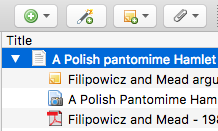
Zotero is, at the most basic level, a reference manager. It is designed to store, manage, and cite bibliographic references, such as books and articles. In Zotero, each of these references constitutes an item. More broadly, Zotero is a powerful tool for collecting and organizing research information and sources.
- What kind of items are there?
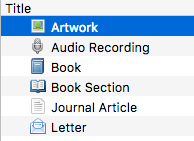
Every item contains different metadata, depending on what type it is. Items can be everything from books, articles, and reports to web pages, artwork, films, letters, manuscripts, sound recordings, bills, cases, or statutes, among many others.
- What can I do with items?
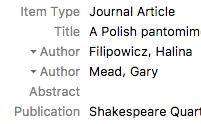
Items appear in Zotero's center pane. The metadata for that item is shown in the right pane. This includes titles, creators, publishers, dates, page numbers, and any other data needed to cite the item.
- Collections
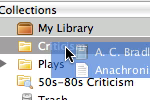
Items can be assigned tags . Tags are named by the user. An item can be assigned as many tags as is needed. Tags are added or removed with the tag selector at the bottom of the left pane or through the Tags tab of any item in the right-hand pane. Up to 6 tags can be assigned colors . Colored tags are readily visible in the item list and can be quickly added or removed using the number keys on your keyboard.
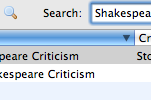
Quick searches show items whose metadata, tags, or fulltext content match the search terms and are performed from the Zotero toolbar. Clicking the spyglass icon to the left of the search box opens the Advanced Search window, allowing for more complex or narrow searches.
- Saved Searches
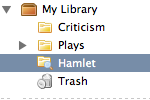
Advanced searches can be saved in the left pane They are similar to collections, but will update with new matching items automatically.
- Attachments
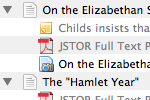
Items can have notes, files, and links attached to them. These attachments appear in the middle pane underneath their parent item. Attachments can be shown or hidden by clicking the arrow next to their parent item.
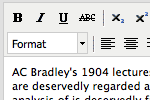
Any type of file can be attached to an item. Attach files with the Add Attachment (paperclip) button in the Zotero toolbar, by right-clicking on an existing item, or by drag-and-dropping. Files do not need to be attached to existing items. They can simply be added to your library. Files can also be downloaded automatically when you import items using the Zotero Connector in your browser .
- Links & Snapshots

Web pages can be attached to any item as a link or a snapshot. A link simply opens the website online. Zotero can also save a snapshot of a web page. A snapshot is a locally stored copy of a web page in the same state as it was when it was saved. Snapshots are available without an internet connection.
- Capturing Items
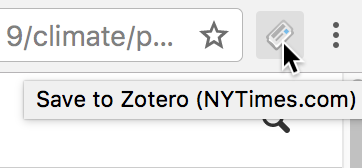
With the Zotero Connector for Chrome, Firefox, or Safari, it's simple to create new items from information available on the internet. With the click of a button, Zotero can automatically create an item of the appropriate type and populate the metadata fields, download a full-text PDF if available, and attach useful links (e.g., to the PubMed entry) or Supplemental Data files.
- Single or Multiple Captures
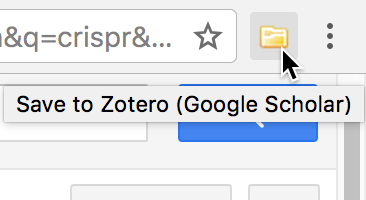
If the save icon is a book, article, image, or other single item, clicking on it will add the item to the current collection in Zotero. If the save icon is a folder, the webpage contains multiple items. Clicking it will open a dialog box from which items can be selected and saved to Zotero.
- Translators
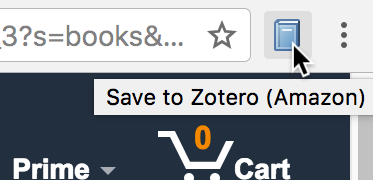
Zotero uses bits of code called translators to recognize information on webpages. There are generic translators which work with many sites and translators written for individual sites. If a site you're using does not have a translator, feel free to request one on the Zotero Forums .
- Saving a Web Page

If the Zotero Connector does not recognize data on the page, you can still click the save button in the browser toolbar to save the page as a Web Page item with an attached snapshot. While this will save basic metadata (title, URL , access date), you may need to fill in additional metadata from the page by hand.
- Add Item by Identifier
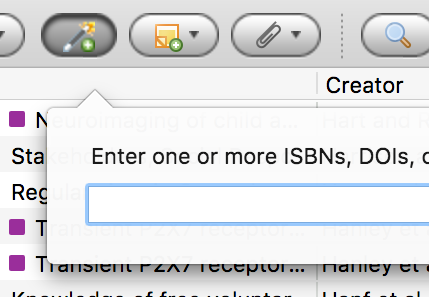
Subscribe to RSS feeds from your favorite journals or websites to keep up to date with the latest research. Go to the article web page or save items to your library with the click of a button.
- Manually Adding Items

- Citing Items
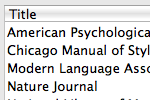
Zotero uses Citation Style Language (CSL) to properly format citations in many different bibliographic styles . Zotero supports all the major styles (Chicago, MLA, APA, Vancouver, etc.) as well as the specific styles for over 8,000 journals and publishers.
- Word Processor Integration
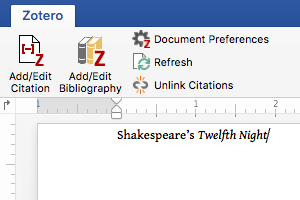
Zotero's Word, LibreOffice, and Google Docs plugins allow users to insert citations directly from their word processing software. This makes citing multiple pages or sources or otherwise customizing citations a breeze. In-text citations, footnotes and endnotes are all supported. With community-developed plugins , Zotero can also be used with LaTeX, Scrivener, and numerous other writing programs.
- Automatic Bibliographies
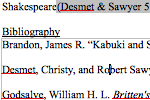
Using the word processor plugins makes it possible to automatically generate a bibliography from the items cited and to switch citation styles for the entire document with the click of a button.
- Manual Bibliographies
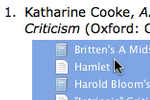
Zotero can also insert citations and bibliographies into any text field or program. Simply drag-and-drop items, use Quick Copy to send citations to the clipboard, or export them directly to a file.
Collaborate
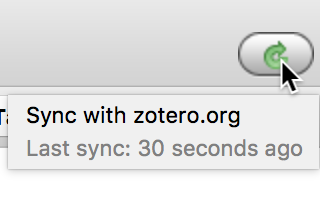
Use Zotero on multiple computers with Zotero syncing . Library items and notes are synced through the Zotero servers (unlimited storage), while attachment syncing can use the Zotero servers or your own WebDAV service to sync files such as PDFs, images, or audio/video.
- Zotero Servers
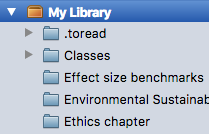
Items synced to the Zotero servers can be accessed online through your zotero.org account. Share your library with others or create a custom C.V. from selected items.
Make copies of your research readily available on zotero.org for readers, the public, and other researchers using My Publications .
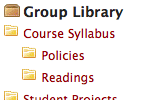
Zotero users can create collaborative or interest groups . Shared group libraries make it possible to collaboratively manage research sources and materials, both online and through the Zotero client. Zotero.org can be the hub of all your project group's research, communication and organization.
Table of Contents
- Old revisions

Title Page Setup
A title page is required for all APA Style papers. There are both student and professional versions of the title page. Students should use the student version of the title page unless their instructor or institution has requested they use the professional version. APA provides a student title page guide (PDF, 199KB) to assist students in creating their title pages.
Student title page
The student title page includes the paper title, author names (the byline), author affiliation, course number and name for which the paper is being submitted, instructor name, assignment due date, and page number, as shown in this example.

Title page setup is covered in the seventh edition APA Style manuals in the Publication Manual Section 2.3 and the Concise Guide Section 1.6
Related handouts
- Student Title Page Guide (PDF, 263KB)
- Student Paper Setup Guide (PDF, 3MB)
Student papers do not include a running head unless requested by the instructor or institution.
Follow the guidelines described next to format each element of the student title page.
|
|
|
|
|---|---|---|
| Paper title | Place the title three to four lines down from the top of the title page. Center it and type it in bold font. Capitalize of the title. Place the main title and any subtitle on separate double-spaced lines if desired. There is no maximum length for titles; however, keep titles focused and include key terms. |
|
| Author names | Place one double-spaced blank line between the paper title and the author names. Center author names on their own line. If there are two authors, use the word “and” between authors; if there are three or more authors, place a comma between author names and use the word “and” before the final author name. | Cecily J. Sinclair and Adam Gonzaga |
| Author affiliation | For a student paper, the affiliation is the institution where the student attends school. Include both the name of any department and the name of the college, university, or other institution, separated by a comma. Center the affiliation on the next double-spaced line after the author name(s). | Department of Psychology, University of Georgia |
| Course number and name | Provide the course number as shown on instructional materials, followed by a colon and the course name. Center the course number and name on the next double-spaced line after the author affiliation. | PSY 201: Introduction to Psychology |
| Instructor name | Provide the name of the instructor for the course using the format shown on instructional materials. Center the instructor name on the next double-spaced line after the course number and name. | Dr. Rowan J. Estes |
| Assignment due date | Provide the due date for the assignment. Center the due date on the next double-spaced line after the instructor name. Use the date format commonly used in your country. | October 18, 2020 |
|
| Use the page number 1 on the title page. Use the automatic page-numbering function of your word processing program to insert page numbers in the top right corner of the page header. | 1 |
Professional title page
The professional title page includes the paper title, author names (the byline), author affiliation(s), author note, running head, and page number, as shown in the following example.

Follow the guidelines described next to format each element of the professional title page.
|
|
|
|
|---|---|---|
| Paper title | Place the title three to four lines down from the top of the title page. Center it and type it in bold font. Capitalize of the title. Place the main title and any subtitle on separate double-spaced lines if desired. There is no maximum length for titles; however, keep titles focused and include key terms. |
|
| Author names
| Place one double-spaced blank line between the paper title and the author names. Center author names on their own line. If there are two authors, use the word “and” between authors; if there are three or more authors, place a comma between author names and use the word “and” before the final author name. | Francesca Humboldt |
| When different authors have different affiliations, use superscript numerals after author names to connect the names to the appropriate affiliation(s). If all authors have the same affiliation, superscript numerals are not used (see Section 2.3 of the for more on how to set up bylines and affiliations). | Tracy Reuter , Arielle Borovsky , and Casey Lew-Williams | |
| Author affiliation
| For a professional paper, the affiliation is the institution at which the research was conducted. Include both the name of any department and the name of the college, university, or other institution, separated by a comma. Center the affiliation on the next double-spaced line after the author names; when there are multiple affiliations, center each affiliation on its own line.
| Department of Nursing, Morrigan University |
| When different authors have different affiliations, use superscript numerals before affiliations to connect the affiliations to the appropriate author(s). Do not use superscript numerals if all authors share the same affiliations (see Section 2.3 of the for more). | Department of Psychology, Princeton University | |
| Author note | Place the author note in the bottom half of the title page. Center and bold the label “Author Note.” Align the paragraphs of the author note to the left. For further information on the contents of the author note, see Section 2.7 of the . | n/a |
|
| The running head appears in all-capital letters in the page header of all pages, including the title page. Align the running head to the left margin. Do not use the label “Running head:” before the running head. | Prediction errors support children’s word learning |
|
| Use the page number 1 on the title page. Use the automatic page-numbering function of your word processing program to insert page numbers in the top right corner of the page header. | 1 |
Grab your spot at the free arXiv Accessibility Forum
Help | Advanced Search
Computer Science > Digital Libraries
Title: creating publishing accounts for university professors on global scientific websites (orcid, research gate, google scholar).
Abstract: Perhaps among the most prominent sites on which we always encourage professors to create accounts are (ORCID), (Reserach Gate), and (Google Scholar), and how to publish and promote their research through social media or through educational platforms, conferences, and scientific workshops Then we try to explain, in the course of the research, in a smooth manner, the ways to activate accounts on these platforms, supported by pictures and a comprehensive step-by-step explanation, as a gesture to encourage the spread of the culture of electronic publishing in light of the escalation of the digital and computing revolution and the desire to catch up with its accelerating pace
| Comments: | documentation, accounts, programs, quotation, creation, SQL, Orchid, Research Ki |
| Subjects: | Digital Libraries (cs.DL) |
| classes: | Researcher |
| Cite as: | [cs.DL] |
| (or [cs.DL] for this version) | |
| Focus to learn more arXiv-issued DOI via DataCite |
Submission history
Access paper:.
- Other Formats
References & Citations
- Google Scholar
- Semantic Scholar
BibTeX formatted citation
Bibliographic and Citation Tools
Code, data and media associated with this article, recommenders and search tools.
- Institution
arXivLabs: experimental projects with community collaborators
arXivLabs is a framework that allows collaborators to develop and share new arXiv features directly on our website.
Both individuals and organizations that work with arXivLabs have embraced and accepted our values of openness, community, excellence, and user data privacy. arXiv is committed to these values and only works with partners that adhere to them.
Have an idea for a project that will add value for arXiv's community? Learn more about arXivLabs .
Scribbr Citation Generator
Accurate APA, MLA, Chicago, and Harvard citations, verified by experts, trusted by millions

Scribbr for Chrome: Your shortcut to citations
Cite any page or article with a single click right from your browser. The extension does the hard work for you by automatically grabbing the title, author(s), publication date, and everything else needed to whip up the perfect citation.
| ⚙️ Styles | APA, MLA, Chicago, Harvard |
|---|---|
| 📚 Source types | Websites, books, articles |
| 🔎 Autocite | Search by title, URL, DOI, or ISBN |

Perfectly formatted references every time
Inaccurate citations can cost you points on your assignments, so our seasoned citation experts have invested countless hours in perfecting Scribbr’s citation generator algorithms. We’re proud to be recommended by teachers and universities worldwide.
Enjoy a citation generator without flashy ads
Staying focused is already difficult enough, so unlike other citation generators, Scribbr won’t slow you down with flashing banner ads and video pop-ups. That’s a promise!
Citation Generator features you'll love
Look up your source by its title, URL, ISBN, or DOI, and let Scribbr find and fill in all the relevant information automatically.
APA, MLA, Chicago, and Harvard
Generate flawless citations according to the official APA, MLA, Chicago, Harvard style, or many other rules.
Export to Word
When your reference list is complete, export it to Word. We’ll apply the official formatting guidelines automatically.
Lists and folders
Create separate reference lists for each of your assignments to stay organized. You can also group related lists into folders.
Export to Bib(La)TeX
Are you using a LaTex editor like Overleaf? If so, you can easily export your references in Bib(La)TeX format with a single click.
Custom fonts
Change the typeface used for your reference list to match the rest of your document. Options include Times New Roman, Arial, and Calibri.
Industry-standard technology
Scribbr’s Citation Generator is built using the same citation software (CSL) as Mendeley and Zotero, but with an added layer for improved accuracy.
Annotations
Describe or evaluate your sources in annotations, and Scribbr will generate a perfectly formatted annotated bibliography .
Citation guides
Scribbr’s popular guides and videos will help you understand everything related to finding, evaluating, and citing sources.
Secure backup
Your work is saved automatically after every change and stored securely in your Scribbr account.
- Introduction
- Finding sources
Evaluating sources
- Integrating sources
Citing sources
Tools and resources, a quick guide to working with sources.
Working with sources is an important skill that you’ll need throughout your academic career.
It includes knowing how to find relevant sources, assessing their authority and credibility, and understanding how to integrate sources into your work with proper referencing.
This quick guide will help you get started!
Finding relevant sources
Sources commonly used in academic writing include academic journals, scholarly books, websites, newspapers, and encyclopedias. There are three main places to look for such sources:
- Research databases: Databases can be general or subject-specific. To get started, check out this list of databases by academic discipline . Another good starting point is Google Scholar .
- Your institution’s library: Use your library’s database to narrow down your search using keywords to find relevant articles, books, and newspapers matching your topic.
- Other online resources: Consult popular online sources like websites, blogs, or Wikipedia to find background information. Be sure to carefully evaluate the credibility of those online sources.
When using academic databases or search engines, you can use Boolean operators to refine your results.
Generate APA, MLA, Chicago, and Harvard citations in seconds
Get started
In academic writing, your sources should be credible, up to date, and relevant to your research topic. Useful approaches to evaluating sources include the CRAAP test and lateral reading.
CRAAP is an abbreviation that reminds you of a set of questions to ask yourself when evaluating information.
- Currency: Does the source reflect recent research?
- Relevance: Is the source related to your research topic?
- Authority: Is it a respected publication? Is the author an expert in their field?
- Accuracy: Does the source support its arguments and conclusions with evidence?
- Purpose: What is the author’s intention?
Lateral reading
Lateral reading means comparing your source to other sources. This allows you to:
- Verify evidence
- Contextualize information
- Find potential weaknesses
If a source is using methods or drawing conclusions that are incompatible with other research in its field, it may not be reliable.
Integrating sources into your work
Once you have found information that you want to include in your paper, signal phrases can help you to introduce it. Here are a few examples:
| Function | Example sentence | Signal words and phrases |
|---|---|---|
| You present the author’s position neutrally, without any special emphasis. | recent research, food services are responsible for one-third of anthropogenic greenhouse gas emissions. | According to, analyzes, asks, describes, discusses, explains, in the words of, notes, observes, points out, reports, writes |
| A position is taken in agreement with what came before. | Recent research Einstein’s theory of general relativity by observing light from behind a black hole. | Agrees, confirms, endorses, reinforces, promotes, supports |
| A position is taken for or against something, with the implication that the debate is ongoing. | Allen Ginsberg artistic revision … | Argues, contends, denies, insists, maintains |
Following the signal phrase, you can choose to quote, paraphrase or summarize the source.
- Quoting : This means including the exact words of another source in your paper. The quoted text must be enclosed in quotation marks or (for longer quotes) presented as a block quote . Quote a source when the meaning is difficult to convey in different words or when you want to analyze the language itself.
- Paraphrasing : This means putting another person’s ideas into your own words. It allows you to integrate sources more smoothly into your text, maintaining a consistent voice. It also shows that you have understood the meaning of the source.
- Summarizing : This means giving an overview of the essential points of a source. Summaries should be much shorter than the original text. You should describe the key points in your own words and not quote from the original text.
Whenever you quote, paraphrase, or summarize a source, you must include a citation crediting the original author.
Citing your sources is important because it:
- Allows you to avoid plagiarism
- Establishes the credentials of your sources
- Backs up your arguments with evidence
- Allows your reader to verify the legitimacy of your conclusions
The most common citation styles are APA, MLA, and Chicago style. Each citation style has specific rules for formatting citations.
Generate APA, MLA, Chicago, and Harvard citations in seconds
Scribbr offers tons of tools and resources to make working with sources easier and faster. Take a look at our top picks:
- Citation Generator: Automatically generate accurate references and in-text citations using Scribbr’s APA Citation Generator, MLA Citation Generator , Harvard Referencing Generator , and Chicago Citation Generator .
- Plagiarism Checker : Detect plagiarism in your paper using the most accurate Turnitin-powered plagiarism software available to students.
- AI Proofreader: Upload and improve unlimited documents and earn higher grades on your assignments. Try it for free!
- Paraphrasing tool: Avoid accidental plagiarism and make your text sound better.
- Grammar checker : Eliminate pesky spelling and grammar mistakes.
- Summarizer: Read more in less time. Distill lengthy and complex texts down to their key points.
- AI detector: Find out if your text was written with ChatGPT or any other AI writing tool. ChatGPT 2 & ChatGPT 3 supported.
- Proofreading services : Have a human editor improve your writing.
- Citation checker: Check your work for citation errors and missing citations.
- Knowledge Base : Explore hundreds of articles, bite-sized videos, time-saving templates, and handy checklists that guide you through the process of research, writing, and citation.

IMAGES
COMMENTS
Citing a website in MLA Style. An MLA Works Cited entry for a webpage lists the author's name, the title of the page (in quotation marks), the name of the site (in italics), the date of publication, and the URL. The in-text citation usually just lists the author's name. For a long page, you may specify a (shortened) section heading to ...
Revised on January 17, 2024. APA website citations usually include the author, the publication date, the title of the page or article, the website name, and the URL. If there is no author, start the citation with the title of the article. If the page is likely to change over time, add a retrieval date. If you are citing an online version of a ...
This guide explains all of the important steps to referencing a website/web page in your APA research papers. The guidance below follows APA style, 7th edition. ... An APA citation of web page reference includes the month, day, and year if it's a site that is updated with new information frequently. Blog posts, newspaper articles, posts from ...
At college level, you must properly cite your sources in all essays, research papers, and other academic texts (except exams and in-class exercises). Add a citation whenever you quote, paraphrase, or summarize information or ideas from a source. You should also give full source details in a bibliography or reference list at the end of your text.
Provide the name of the news website in the source element of the reference. Link to the comment itself if possible. Otherwise, link to the webpage on which the comment appears. Either a full URL or a short URL is acceptable. 3. Webpage on a website with a government agency group author.
To reference a website in Harvard style, include the name of the author or organization, the year of publication, the title of the page, the URL, and the date on which you accessed the website. In-text citation example. (Google, 2020) Reference template. Author surname, initial. ( Year) Page Title.
The manual way to cite a website. To cite a website by hand just follow the instructions below. For the 3 most popular styles-APA, MLA 8, and Harvard-this is as follows: In APA style. You need to locate these details for the website: page or article author, page or article title, website name, published date, access date, page URL (web ...
Web pages authored by a company or organization. Here's the information you will need to include for this type of reference: Name of the company/organization. Year the site was published or last updated (in round brackets) Title of the web page (in italics) Available at: URL (Accessed: date) In-text citation.
3. Type the title of the web page in sentence case. Type a space after the period that follows the date, then type the title of the web page, which will usually appear as a header at the top of the page. Use sentence case, capitalizing only the first word and any proper nouns. Place a period at the end of the title.
Referencing: A guide to citation rules (3rd ed.). New York, NY: My Publisher . How to Cite a Chapter in an Edited Book in APA Format. Edited books are collations of chapters written by different authors. To reference a single chapter, a different format is needed. The basic structure is as follows: Edited book chapter example:
Reference List. Resources on writing an APA style reference list, including citation formats. Basic Rules Basic guidelines for formatting the reference list at the end of a standard APA research paper Author/Authors Rules for handling works by a single author or multiple authors that apply to all APA-style references in your reference list ...
The Chicago/Turabian style of citing sources is generally used when citing sources for humanities papers, and is best known for its requirement that writers place bibliographic citations at the bottom of a page (in Chicago-format footnotes) or at the end of a paper (endnotes). The Turabian and Chicago citation styles are almost identical, but ...
When using APA format, follow the author-date method of in-text citation. This means that the author's last name and the year of publication for the source should appear in the text, like, for example, (Jones, 1998). One complete reference for each source should appear in the reference list at the end of the paper.
When you cite a source with up to three authors, cite all authors' names. For four or more authors, list only the first name, followed by ' et al. ': Number of authors. In-text citation example. 1 author. (Davis, 2019) 2 authors. (Davis and Barrett, 2019) 3 authors.
the page, paragraph or section number—what you cite will depend on the information available as many electronic or online sources don't have pages. provide an accurate access date for online sources, that is, identify when a source was viewed or downloaded. provide the location of an online source, for example, a database or web address.
Revised on March 5, 2024. An MLA website citation includes the author's name, the title of the page (in quotation marks), the name of the website (in italics), the publication date, and the URL (without "https://"). If the author is unknown, start with the title of the page instead. If the publication date is unknown, or if the content is ...
In-text citations are quick references to your sources. In Harvard referencing, you use the author's surname and the date of publication in brackets. Up to three authors are included in a Harvard in-text citation. If the source has more than three authors, include the first author followed by ' et al. '.
Enter the website's URL into the search box above. You'll get a list of results, so you can identify and choose the correct source you want to cite. It's that easy to begin! If you're wondering how to cite a website in APA, use the structure below. Structure: Author Last Name, First initial.
There are different versions of the Harvard referencing style. This guide is a quick introduction to the commonly-used Cite Them Right version. You will find further guidance available through the OU Library on the Cite Them Right Database. For help and support with referencing and the full Cite Them Right guide, have a look at the Library's ...
To use the reference generator, simply: Select your style from Harvard, APA, OSCOLA and many more*. Choose the type of source you would like to cite (e.g. website, book, journal, video) Enter the URL, DOI, ISBN, title, or other unique source information to find your source. Click the 'Cite' button on the reference generator.
When no individual author name is listed, but the source can clearly be attributed to a specific organization—e.g., a press release by a charity, a report by an agency, or a page from a company's website—use the organization's name as the author in the reference entry and APA in-text citations.. When no author at all can be determined—e.g. a collaboratively edited wiki or an online ...
Related Read: How to Write a Research Paper Conclusion. 6. Cite your sources. The key to learning how to write a research paper is learning how to cite sources. Depending on the style guide you're following, you may need to create in-text citations, a Works Cited page, a reference list, a bibliography, or footnotes. Pay close attention to ...
The left pane includes My Library, which contains all the items in your library. Right-click on My Library or click on the New Collection button above the left pane to create a new collection, a folder into which items relating to a specific project or topic can be placed.Think of collections like playlists in a music player: items in collections are aliases (or "links") to a single copy ...
For a professional paper, the affiliation is the institution at which the research was conducted. Include both the name of any department and the name of the college, university, or other institution, separated by a comma. Center the affiliation on the next double-spaced line after the author names; when there are multiple affiliations, center ...
On the APA reference page, you list all the sources that you've cited in your paper. The list starts on a new page right after the body text. Follow these instructions to set up your APA reference page: Place the section label "References" in bold at the top of the page (centered). Order the references alphabetically. Double-space all text.
Perhaps among the most prominent sites on which we always encourage professors to create accounts are (ORCID), (Reserach Gate), and (Google Scholar), and how to publish and promote their research through social media or through educational platforms, conferences, and scientific workshops Then we try to explain, in the course of the research, in a smooth manner, the ways to activate accounts on ...
Citation Generator: Automatically generate accurate references and in-text citations using Scribbr's APA Citation Generator, MLA Citation Generator, Harvard Referencing Generator, and Chicago Citation Generator. Plagiarism Checker: Detect plagiarism in your paper using the most accurate Turnitin-powered plagiarism software available to ...